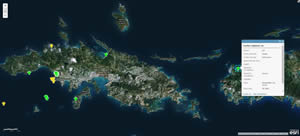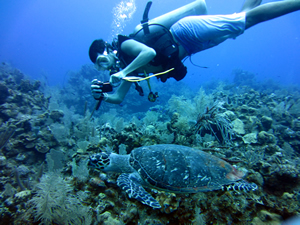Researcher Easily Built His First App by Using AppStudio for ArcGIS
Snorkelers, scuba divers, and beachgoers who spot sea turtles can help scientific researchers learn more about the elusive and often endangered marine reptiles.
All they need to do is download an app called TURT (Turtles Uniting Researchers and Tourists) onto their smartphone before they hit the beach or go out on the water. The app is available on iOS and Android.
Dustin Baumbach, a PhD student and marine researcher at Loma Linda University in California, built TURT using AppStudio for ArcGIS, which Esri developed to help users create mobile mapping apps quickly. The mapped data from TURT is available for sea turtle research, including the work being done by the non-profit Protective Turtle Ecology Center for Training, Outreach and Research, Inc., (ProTECTOR).
"Data uploaded by scientists and citizen scientists [will] help our research by mapping out locations of turtles to help us track population numbers within countries and, through the help of photo identification (photo ID), track individuals on a global scale," Baumbach said.
Today in places such as the US Virgin Islands, Honduras, and Hawaii, sea turtles can frequently be spotted swimming along ocean currents or crawling onto beaches to lay their eggs.
When TURT app users see a sea turtle, they can snap a photo of the marine reptile; add its location on a map; choose from a list to indicate the type of turtle—for example, Hawksbill, Loggerhead, or Olive Ridley—they spotted; and type in some details such as the weather conditions, depth of the ocean, and time of day and date of the sighting.
Once data is added to the TURT app, it is automatically and instantaneously uploaded to a global sea turtle database via a web map stored in Esri ArcGIS Online. Researchers and conservationists use the information to analyze trends and hot spots to assess the distribution, health, and migration activities of the various sea turtle species.
TURT turns tourists into citizen scientists, reporting on creatures that have cruised the oceans for 100 million years. The information people collect is important, because nearly all the seven species of marine reptiles are now classified as endangered, according to the National Oceanic and Atmospheric Administration (NOAA).
Baumbach worked on the TURT project with Stephen Dunbar, a professor in the Loma Linda University School of Medicine's department of earth and biological sciences. Dunbar has been studying sea turtles for 10 years in places such as the Caribbean Sea and Honduras. Baumbach joined Dunbar in his research for two summers, which prompted the idea for a smartphone app that would assist sea turtle conservation researchers.
"Researchers are not able to be at their field site all year long, but divers are there every day," Baumbach said. "Sea turtles are a critically endangered species, and this app can help conserve them while also educating other researchers and the public."
A map is available to ArcGIS Online users that shows all the turtle sightings collected by the app's users.

This map, available to view in ArcGIS Online, shows the sea turtle species and locations of sightings that have been documented by the TURT app users around the world.
To build TURT, Baumbach selected AppStudio for ArcGIS because it allowed him to create a consumer-friendly mobile app that works with Android, iOS, Windows, Mac OS X, and Linux. The app can be used in offline mode, so divers in remote areas without cell phone coverage can still record sightings. Moreover, using AppStudio for ArcGIS let Baumbach publish TURT in app stores, using his own brand. In this case, he employed branding from ProTECTOR, Dunbar's nonprofit organization.
"I had never made an app before, but AppStudio was very simple to use," Baumbach said. "I downloaded the app, put all my info into the Quick Report template, and then customized it using the AppStudio language. Being able to deploy the app across platforms is a big benefit. And it's good that we can brand it through our organization."

A pop-up provides details of a sea turtle sighting on the island of Saint John, U.S. Virgin Islands.
Baumbach and Dunbar have started promoting the app to dive operators around the world, with a focus on the Caribbean, Thailand, Malaysia, Australia, and Indonesia, since those are places where people have already started uploading sightings. Additionally, the app allows users to map places where sea turtle products, such as souvenirs made from their shells or sea turtle meat, are being sold and thus help curb these illegal dealings.
"We are able to track the locations where turtle products are being sold so that we can work with local governments to stop this illegal trade," Baumbach said.
The TURT app is free and can be found in the Apple and Google Play app stores.







No hay comentarios:
Publicar un comentario